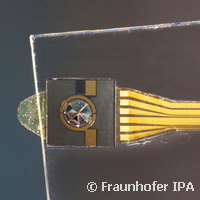Reducing the costs and trauma of inner ear implant surgery
People who are hard of hearing not only face the risk of slipping into social isolation due to their condition but, more seriously, they can also be at risk during simple, everyday activities: such as driving a car or crossing the road. This is why hearing aids are a must for people over the age of 65 in Europe whose hearing is poor ? almost 50 per cent of this age group. Not only do these devices help keep them engage with the world around them, but they also make them aware of its dangers. However, for many sufferers, their hearing is so damaged that a standard hearing aid is no longer enough. These patients' hearing can only be helped by an implant which amplifies sounds more effectively than conventional systems and with better sound quality. The downside of these middle-ear implants is that installing them is a complex surgical operation which can last for several hours. The high risk and expense of this surgery mean that it is rarely performed. But help is at hand. Researchers from the Fraunhofer Institute for Manufacturing Engineering and Automation (IPA) in Stuttgart are developing a new device which will improve patients' hearing and can be implanted during outpatient surgery thus avoiding a stay in hospital. The implant is composed of three parts: a case with a microphone and battery; wireless, optical signal and energy transmission between the outer and middle ear; and an electro-acoustic transducer ? the centrepiece and loudspeaker of the implant. This transducer is a disc approximately 1.2 mm in diameter. "Our goal is to take the better sound quality of implantable hearing aids and combine it with a much simplified operation," says Dominik Kaltenbacher, engineer at IPA. "To implant our system, all surgeons have to do is make a small incision at the side of the eardrum and then fold it forward. This can be done in outpatient surgery." The electro-acoustic transducer is placed directly at the connection between the middle and inner ear known as the "round window". From there it transmits acoustic signals to the inner ear in the form of amplified mechanical vibrations, thereby enhancing the hearing capacity of patients. Although the round window implant is no larger than a pinhead, it can emit sound levels of up to 120 decibels - roughly the noise a jackhammer makes. "This high performance is necessary for very good speech comprehension, particularly for high-pitched sounds, which people who are severely hard of hearing find especially difficult to pick up," says Dominik Kaltenbacher. Experts are currently testing a first working prototype in the laboratory. Results have been positive to date. The optimised individual components should be ready by June this year, and testing of the overall system is planned for 2014.For more information, please visit: http://www.fraunhofer.de/en/press/research-news.html(opens in new window)
Countries
Germany



